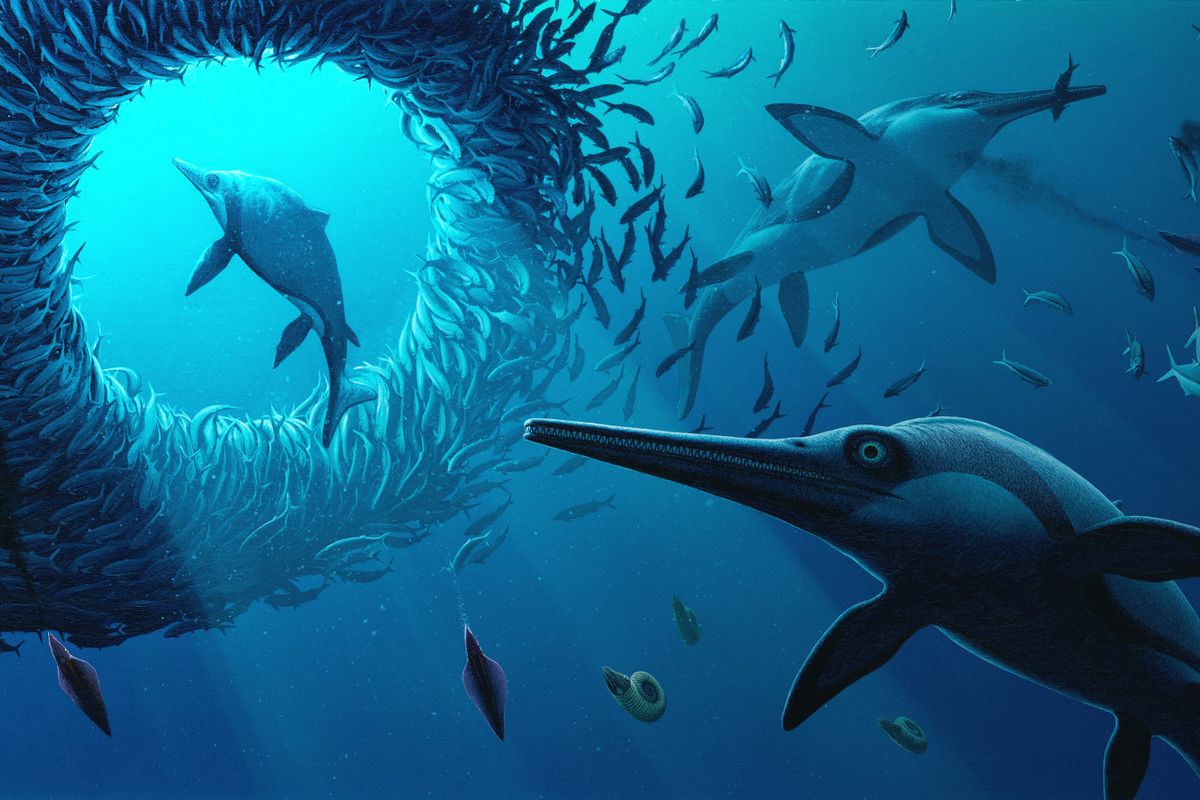Some ichthyosaurs are too old, and some ichthyosaurs are too young. But a new species of marine reptile is the perfect age — that is, for revealing one of the most mysterious periods in the ichthyosaur fossil record.
According to a new study in Papers in Palaeontology, a strange new ichthyosaur species has been described from Golden Cap, a cliff along the Jurassic Coast in Dorset, England. Named Xiphodracon goldencapensis, or “Sword Dragon from Golden Cap,” for its long snout and its sharp teeth, this fearsome ichthyosaur is the first to have been discovered from the Early Jurassic Pliensbachian period (around 193 million to 184 million years ago), filling in a long-lost interval in the ichthyosaurs’ evolution.
“Thousands of complete or nearly complete ichthyosaur skeletons are known from strata before and after the Pliensbachian,” said Judy Massare, a study author and a paleontologist at the State University of New York, according to a press release. “The two faunas are quite distinct, with no species in common, even though the overall ecology is similar. Clearly, a major change in species diversity occurred sometime in the Pliensbachian. Xiphodracon helps to determine when the change occurred.”
Read More: First Ever Pregnant Ichthyosaur from the Early Cretaceous Reveals Life in Prehistoric Seas
Filling in the Ichthyosaur Family Tree
The fossil itself was discovered by Chris Moore, a fossil collector based in Dorset, in 2001. Though fossilized ichthyosaur specimens have been dug up in Dorset for centuries, this skeleton stood out, in part due to its pristine preservation.
The skeleton and skull of the newly named sword dragon ichthyosaur, Xiphodracon goldencapensis.
(Image Credit: © Courtesy of Dr Dean Lomax)
“I remember seeing the skeleton for the first time in 2016,” said Dean Lomax, another study author and a paleontologist at the University of Manchester, according to the release. “Back then, I knew it was unusual, but I did not expect it to play such a pivotal role in helping to fill a gap in our understanding of a complex faunal turnover during the Pliensbachian.”
The team’s phylogenetic analysis of the fossil suggested that the specimen was less like the ichthyosaurs of the earlier Sinemurian period (around 199 million to 193 years ago) and more like the ichthyosaurs of the later Toarcian period (around 184 million to 180 million years ago). This helped date the dramatic transformation in the Pliensbachian, in which several species went extinct, and several species emerged, each with their own morphologies.
“Xiphodracon is something you might call a ‘missing piece of the ichthyosaur puzzle,’” Lomax added in the release. “It is more closely related to species in the later Early Jurassic (in the Toarcian), and its discovery helps pinpoint when the faunal turnover occurred, being much earlier than expected.”
A Perfect Perservation
According to the study authors, the fossil may represent one of the most perfectly preserved reptiles from the Pliensbachian. In fact, the specimen is practically complete, missing parts from one of the fins and the tail, and including a long-snouted, sharp-toothed skull in immaculate condition. The team says that the fossil is so comprehensive that it could contain a few leftovers from the ichthyosaur’s final feast, most likely a meal of fish or squid.
“This skeleton provides critical information for understanding ichthyosaur evolution, but also contributes to our understanding of what life must have been like in the Jurassic,” said Erin Maxwell, another study author and a paleontologist from the Stuttgart State Museum of Natural History, according to the release. “The limb bones and teeth are malformed in such a way that points to serious injury or disease while the animal was still alive, and the skull appears to have been bitten by a large predator — likely another much larger species of ichthyosaur — giving us a cause of death for this individual.”
Ultimately, the fossil provides important insights into the evolution of the ichthyosaurs, while also showcasing a strange combination of ichthyosaur characteristics. Armed with a sword-like snout, and sharp teeth to match, this “Dragon of Dorset” transforms what we know about the Jurassic waters, and about the ferocious ichthyosaurs that swam within.
Read More: Species of Ichthyosaur Is Largest Known Marine Reptile at 80 Feet Long
Article Sources
Our writers at Discovermagazine.com use peer-reviewed studies and high-quality sources for our articles, and our editors review for scientific accuracy and editorial standards. Review the sources used below for this article:
